设计开发的咨询服务公司网站。通过调研和分析,系统拥有管理员和用户两个角色,主要具备注册登录、个人信息修改、用户信息、成功案例、产品资讯、业务承揽、业务咨询、培训信息、培训报名、人才招聘等功能模块。将纸质管理有效实现为在线管理,极大提高工作效率。技术栈nodejs+vue+express,
语言 node.js
框架:Express/koa
前端:Vue.js+elementui
数据库:mysql
数据库工具:Navicat
开发软件:VScode 系统的目标是为管理员和用户搭建一个网上沟通平台,保证双方的安全,并使双方的利益最大化。



3.3.1管理员需求分析
管理员的功能主要是开放给系统的管理人员使用,能够对成功案例进行管理,包括对用户管理、成功案例管理、产品资讯管理、业务承揽管理、业务咨询管理、培训信息管理、培训报名管理、人才招聘管理、资讯类型管理、业务类型管理、培训类型管理、留言反馈、系统管理进行查看,修改和删除、新增等,对系统整体运行情况进行了解。
管理员用例分析图,如图3-1所示。
Express是基于Node.js平台,快速、开放、极简的web开发框架。
通俗理解:Express的作用和Node.js内置的http模块类似,是专门用来创建web服务器的
Express的本质:就是一个npm上的第三方包,提供了快速创建Web服务器的便捷方法
Express是一个简洁、灵活的node.js Web应用开发框架, 它提供一系列强大的功能,比如:模板解析、静态文件服务、中间件、路由控制等等,并且还可以使用插件或整合其他模块来帮助你创建各种 Web前端学习和移动设备应用,是目前最流行的基于Node.js的Web开发框架,并且支持Ejs、jade等多种模板,可以快速地搭建一个具有完整功能的网站
3.3.2用户需求分析
用户的功能主要是对个人账号和密码进行更新管理,对首页、个人中心、业务咨询管理、培训报名管理进行查询详情操作。
用户用例分析图,如图3-2所示。
目 录
目 录 I
第一章 概述 1
1.1研究背景 1
1.2研究目的及意义 2
1.3国内外发展现状 2
1.4 研究内容 3
1.5本文的结构 4
第二章 关键的技术介绍 4
2.3 MySQL简介 6
2.4 B/S架构 7
第三章 系统分析 9
3.1系统需求分析 10
3.2系统可行性分析 11
3.2.1技术可行性 12
3.2.2 经济可行性 13
3.2.3社会可行性 14
3.3功能需求分析 15
3.3.1管理员需求分析 14
3.3.2用户需求分析 14
3.4流程图设计 15
3.4.1 登录流程图 16
3.4.2 添加新用户流程图 17
第四章 系统概要设计 18
4.1系统设计原理 19
4.2功能模块设计 20
4.3 数据库设计 21
4.3.1数据库设计原则 22
4.3.2数据库E-R图设计 23
4.3.3数据库表结构设计 24
第五章 系统功能实现 25
5.1前台功能的实现 26
5.2管理员功能的实现 27
5.3用户功能的实现 27
第六章 系统测试 30
6.1系统测试的目的 31
6.2软件测试过程 32
6.3系统测试用例 33
结 论 34
致 谢 35
参考文献 36






















 848
848

 被折叠的 条评论
为什么被折叠?
被折叠的 条评论
为什么被折叠?










